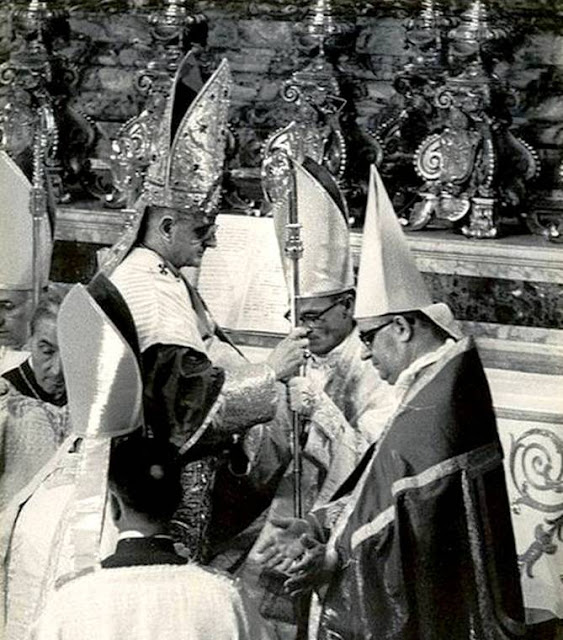Giovanni Battista Montini was born was born in the village of Concesio, in the province of Brescia, on 26th September 1897. He was ordained a priest in Brescia in 1920, but undertook studies whilst working in the Papal Secretariat of State from 1922. He continued in this work throughout the 1920's and 1930's, but when Cardinal Pacelli was elected as Pope in 1939, Monsignor Montini became one of his closest associates. In 1954, Pius XII appointed Monsignor Montini as Archbishop of Milan. Pope John XXIII elevated Monsignor Montini to the Sacred College of Cardinals in 1958.
Pope Paul VI's Pontificate spanned the years of the Second Vatican Council and the troubled years which followed it. He was the first Pope in modern times to travel outside of Italy, visiting the Holy Lands, South America, Africa, Oceania and the United States. He died on 6th August, 1978 at the age of 80 and is buried in the crypt of Saint Peter's Basilica.
An attempt to present a balanced account of his not uncontroversial life and work can be found here.
Figure 4 (above)
This interesting photograph was taken in the Sistine Chapel
after Cardinal Montini had been elected Pope, 21st June 1963
A procession of Cardinals approaches the Pope
to greet him and promise obedience.
Something distinctive seen in this image is that the tables and canopies
where the Cardinals are seated are not covered in crimson or purple cloth but violet.
Figure 5 (above)
The special Papal throne set up at the entrance to Saint Peter's Basilica
for the Solemn Mass and Coronation of Paul VI.
The Feast of Ss Peter and Paul, 1963.
Because it was the height of summer, the rites where carried out in the
late afternoon and night had fallen by the time they had concluded.
Figure 6 (above)
Paul VI at the cathedra shortly after the moment of his Coronation.
This much-commented on triple tiara was made of aluminium and gold
and was a gift of the Archdiocese of Milan.
How they crafted in just one week remains a wonder.
Figure 7 (above)
Paul VI preparing incense during the Solemn Papal Mass of Coronation
celebrated in Saint Peter's Square, 29th June 1963.
This was the first time that a Pope had celebrated Mass in the Square.
Note the array of mitres and triple tiaras resting on the Altar :
a somewhat cluttered disposition.
Figure 8 (above)
Coronation medal of Pope Paul VI.
Figure 9 (above) and Figure 10 (below)
During one of the Sessions of the Second Vatican Council,
the Ugandan Martyrs were canonised in the Basilica. October 1964.
A cage of doves (above) presented to the Pope as part of the ceremonial offerings
explains the smiles on the faces of those in this photograph.
This was the last occasion that the Papal Mass was celebrated with its complete
and elaborate rituals before modifications took place in 1965.
Figure 11 (above)
Pope Paul consecrating missionary bishops at the Altar of the Chair in
Saint Peter's Basilica, 1964.
The images following were taken between 1965 and 1978. The year 1964 marks a distinct phase in the Liturgical aesthetics of Papal Ceremonies. Much simpler forms of papal ceremonial and vesture were introduced, for better and worse.
Figure 12 (above)
Pope Paul offering Mass in the Basilica of the Annunciation
during his Apostolic Voyage to the Holy Lands, 1964.
Figure 13 (above)
Paul VI during a Mass of priestly Ordination in Saint Peter's, 1965.
Figure 14 (above)
Pope Paul preaching during Mass.
The use of the well-known pastoral staff for Papal Ceremonies
had been introduced in 1965. Paul VI had several similar versions
of this staff, one of which continued to be used by his Successors
until quite recently.
Figure 15 (above)
Pope Paul celebrating Low Mass in a Roman Parish.
Figure 16 (above)
May 1969. Newly-elevated members of the Sacred College
concelebrate with Pope Paul in Saint Peter's Basilica.
When concelebration was re-introduced in Rome after 1965, it was customary
for the concelebrants to completely encircle the Altar of the Confession
in the Basilica. This practice was dropped with the introduction
of the New Order of Mass in 1970.
Figure 17 (above)
Pope Paul with the heroic Cardinal Mindzenty of Hungary in the Vatican, 1971.
Figure 18 (above)
Pope Paul kneeling at the threshold of the Holy Door in Saint Peter's
after its Opening for the 1975 Holy Year.
Figure 19 (above)
Pope Paul during his final Mass in Saint Peter's Square, Easter Day 1978.
One of the admirable pieces of Liturgical art produced during the reign of Pope Paul VI was the well-known mitre shewn in the above photograph. This mitre was especially designed and made for Pope Paul by the same artisans in the Archdiocese of Milan who had designed his triple tiara. Ornamented with embroideries of the Four Evangelists, the mitre is also remarkable for its couched gold thread, running in parallel circles. The highest workmanship is evident in this mitre and it is of excellent proportion. In fact, there were several such mitres. One had silver ornament, the other gold. One was left in Australia after the Papal Visit of 1970. After 1966, Pope Paul usually wore this mitre, such that it became identifiable with him.
Pope Saint John Paul II also had made a Four Evangelists mitre, which he wore frequently before the final years of his illness.
Figure 20 (above)
Pope Paul laying-in-state at Castelgandolfo
following his unexpected death on 6th August, 1978.
Changes to ceremonial for the death of a Pope are manifest here in the
simple mitre rather than the cloth gold mitre being used for burial.
AMDG
Next post : Pope John Paul I




















